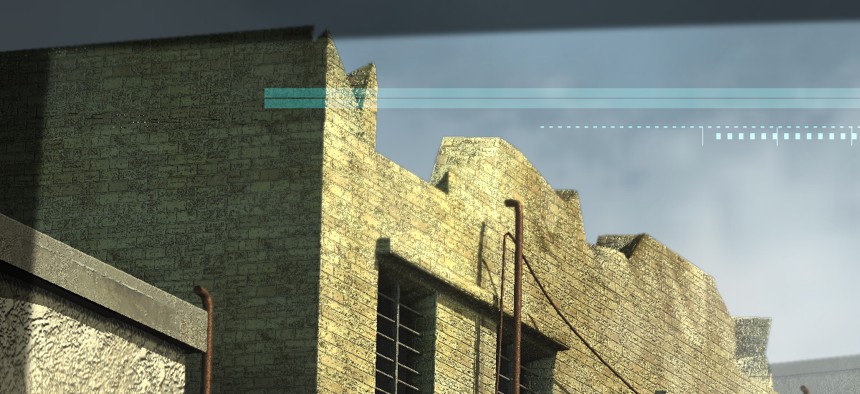
Artist rendering of the SXTC concept. DARPA
Military Looking To Give Troops Super Sensing Abilities
A new DARPA program wants to give soldiers digital ESP.
The Defense Advanced Projects Research Agency, DARPA, on Tuesday announced a new program to give troops unprecedented situational awareness, the ability to sense threats more than half a mile away (1,000 meters) and to understand the location of all of their team even in environments with degraded communications and no GPS.
The Squad X Core Technologies Program, or SXCT, builds off of a multi-year agency effort to shrink the sensing, detecting, and situational awareness capabilities of ships and fighter jets down to what an individual warfighter could carry with him or her. The program looks to bring troops, sensors and especially drones together in a single web of data collecting and communicating, effectively giving military personnel eyes and ears well into the distance.
“Warfighters in aircraft, on ships and in ground vehicles have benefited tremendously from technological advances in recent decades, with advanced capabilities ranging from real-time situational awareness to precision armaments. But many of these benefits depend on equipment with substantial size, weight and power requirements, and so have remained unavailable to dismounted infantry squads who must carry all their equipment themselves,” DARPA said in a press release.
Some quick background -- in a 2013 DARPA request for information, the agency sought new ideas on how to “digitize dismounted squads.” Read that to mean: achieve better integration of computers and sensors to give troops intelligence when they most need it. Some of that digitization is inward facing, physical data on the physical, or even mental, condition of teammates. Most of it relates to the external environment, pregnant with threats.
“By digitization, DARPA means collecting sensor data that would provide much more detailed and actionable real-time information about a squad’s condition, surroundings and adversaries. It is believed that digitization could provide squads of 9 to 13 members and their unmanned assets with enhanced tactical awareness and advantage up to a mile away, in both urban and open‐air environments,” according to a DARPA statement.
The SXCT program is what happens when the Internet of Things meets elite troop training and lethal firepower. But U.S. troops won’t be the only ones trying to use sensors and digital assets to gain tactical advantage in conflict areas. Because consumer information technology moves faster than government invention, consumer mobile tech is often more advanced than what a troop is carrying with him or her into battle. For proof of that, consider that it took until 2010 for the military to even try and build a smart phone, long after people had thrown away their Palm Pilots for iPhones.
The Internet of Things is already a consumer reality across the world, and that has implications for modern warfare. A group of would-be insurgents can create a lot of digital situational awareness capability on their own. Off-the-shelf Wi-Fi detection devices and services like Navizon Indoors to Track can alert an individual to the presence of various smart phones or connected devices in her area. Motion detectors can sound the alarm on moving objects. Drone-mounted GoPro cameras can collect and stream video directly to pretty much any smartphone.
In a world where everyone has cameras, sensors and drones, how does the military make its situational awareness capability more robust than that of a potential adversary? Operating at a longer range is one part of achieving that, hence the program’s emphasis on extending awareness capability to more than half a mile, even when GPS is out.
Another potential strategy is using enemy chatter against the enemy. SXCT puts a heavy emphasis on electronic warfare at the tactical level, which it describes as the ability to “disrupt enemy command and control, communications and use of unmanned assets at a squad-relevant operational pace (walking with occasional bursts of speed.)”
The most important tool that the military can use to make sure its solders can see and sense better than can the enemy is real-time access to highly relevant intelligence.
According to previous statements from the agency and program managers, that might look something like this: A squad would launch a small drone, which would dart around corners and over hills ahead of troops to seek out potential threats. If the drone found a group of people beyond line of sight it could send video footage directly to the squad. More importantly, it might also be able to scan the faces of the subjects it had encountered and an onboard CPU would run the data against a Defense Department database of individuals who had come into contact with personnel in the past. One such database, the Defense Department’s biometrically-enabled watch list, or BEWL, contains more than 209,000 records.
This would — potentially — give troops a preternatural sense of not only what they would be encountering over the next hill, but also … who.




